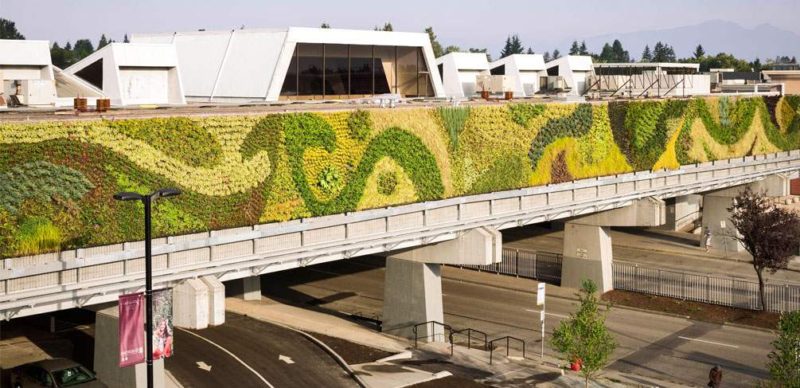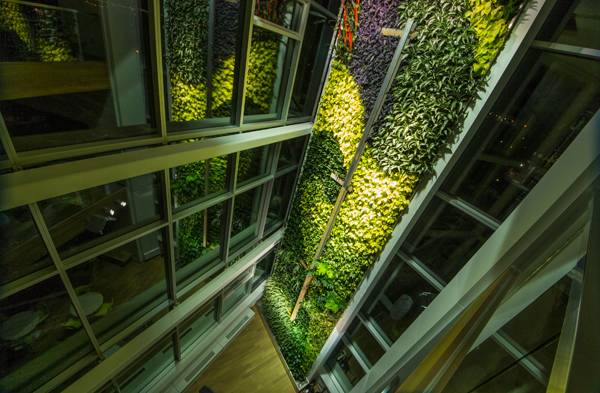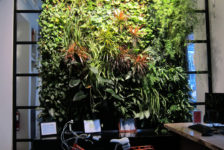Amazing facts about one of the biggest design trends of the 21st century. Green walls, also known as living walls, bio-walls, eco-walls, or vertical gardens, are walls partially or completely covered with vegetation. Some include a growing medium, such as soil, others are grown in hydroponic systems, a method of growing plants using mineral nutrient solutions, in water, without soil. Green walls that require the soil usually feature an irrigation system. These living walls are found all over the world and may be indoors or outside, freestanding or attached to an existing wall, and come in all shapes and sizes. But what is it that makes green walls so fantastic? Following is a list of five green wall facts that stand out from the rest and prove that growing vertical is the new way to grow. 1. Inventor of the Green Wall The first green wall dates back to 1938 when Professor Stanley Hart White of the University of Illinois Urbana-Champaign patented his “Vegetative-Bearing Architectonic Structure and System.” Thankfully, the name has since been shortened. His patent describes a new method “for producing an architectonic structure of any buildable size, shape or height, whose visible or exposed surfaces may present a permanently growing covering of vegetation.” White describes the new technology and art involved in this invention through descriptions and illustrations, and in the process, discovers a new form of garden design not fully realized until after his death. 2. The tallest indoor Green Wall
This green wall, The Currents, rises 65 meters (213 feet) into the air and is located in the Desjardins Building in Quebec. The design group, Green Over Grey, used 11,000 plants comprised of 42 different species set in a hydroponic system to create a wall inspired by the St Lawrence River, which can be seen from the building. This green wall is not only a living piece of art but also a truly natural air purification system for the building. 3. The most diverse Green Wall
This before an after image shows just the kind of incredible transformation a green wall can make. Credit: www.greenovergrey.com
- A Greener Housing Solution Reducing The Impacts in The Neighbourhood
- Residents Get Luxurious Garden and Pool Project in Thailand
- The Central Plaza Parkscape That Has it All
Also designed by Green over Grey, this wall is located in Surrey, British Columbia. The 3000 square foot wall is attached to the Semiahmoo Public Library and Royal Mounted Police Facility and contains more than 10,000 plants comprised of more than 120 different species. This wall also serves a double duty. On the outside, it has become a habitat for birds, bees, and other insects while purifying the air outside. It also serves as insulation, thus reducing the energy costs for the building. 4. The largest outdoor Green Wall Designed by Elmich Pte Ltd in Singapore, the six-story high walls are not confined to a single building, but instead cover seven. The wall was installed in 2012 on the outside of the Institute of Technical Education in Singapore, and serves to block the west-facing walls from the intense tropical sun. It is befitting of a campus that has incorporated environmental sustainability as one of its key strategic programs. Their plan seeks to instill a greater awareness among stakeholders and to embrace green practices while developing new competencies for the green economy of Singapore. You can see it here! 5. The country with the most Green Walls This distinction has to go to Singapore, which is home to hundreds of vertical gardens. In 2013, Alan Tan, with Biophilic Cities, estimated that the country housed some 64,000 square meters (over 688,000 square feet) of vertical gardens. This is in vast contrast to the dangerous, dirty Singapore of the past. Now, Singapore is a success story in many ways, including its strong commitment to all things green. Singapore has embraced environmental sustainability as a way to not only improve the quality of life for its citizens, but also as a way to bring in international business, helping both the country’s economy and its sustainability.

“Creative Commons Changi Airport Terminal 3 Baggage Collection. By Chensiyuan, licensed under CC 2.0
- Planting Green Roofs and Living Walls by Nigel Dunnett
- Gardening Vertically: 24 Ideas for Creating Your Own Green Walls by Noémie Vialard
Article by Erin Tharp Return to Homepage Featured image: credit: www.greenovergrey.com
Published in Blog








